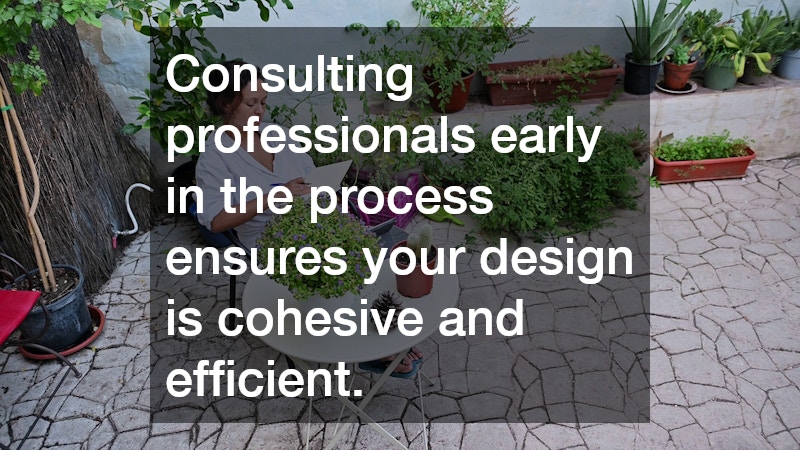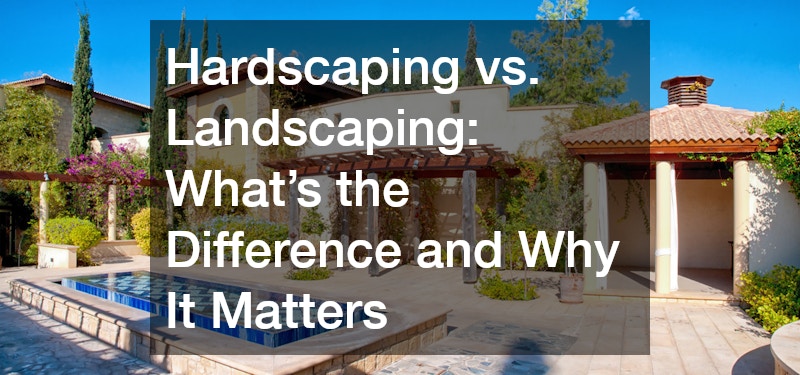Creating a beautiful outdoor space involves more than planting flowers or installing a few pavers. It’s about finding the right balance between hardscaping and landscaping—two essential elements that work together to transform a yard into a functional, eye-catching environment. While the two terms are often used interchangeably, they serve very different purposes in outdoor design. Understanding the distinction between them can help homeowners plan more effectively, choose the right materials, and make the most of their investment.
In this guide, we’ll explore what sets hardscaping apart from landscaping, how each contributes to your outdoor space, and why combining them strategically creates the perfect balance of beauty and function.
1. What Is Hardscaping?
Hardscaping refers to the non-living, structural elements of an outdoor space. Think of everything that’s made from stone, brick, concrete, or wood—the features that give your landscape shape, structure, and permanence.
Examples include patios, retaining walls, walkways, driveways, decks, fire pits, and even outdoor kitchens.
These features serve both aesthetic and functional purposes. A well-designed patio extends your living space, offering a perfect spot for dining or relaxing outdoors. Retaining walls help manage slopes and prevent soil erosion, while pathways and stairs make your yard safer and more accessible.
What makes hardscaping unique is its durability. Unlike plants or turf that require constant maintenance, hardscape elements are built to last for years with minimal upkeep. However, the quality of installation is key. Poorly laid pavers or improperly designed drainage can lead to issues over time. That’s why working with a professional hardscaping service ensures the materials are installed correctly, align with your landscape design, and withstand the elements for the long term.
2. What Is Landscaping?
While hardscaping focuses on structure, landscaping is all about the living components—the greenery that adds color, texture, and movement to your yard. Landscaping includes lawns, trees, shrubs, flowers, and garden beds, along with elements like irrigation systems that help keep your plants thriving.
Landscaping softens the edges of hard materials, creating a natural balance between manmade and organic elements. A lush garden surrounding a stone patio or colorful flower beds lining a walkway add life and vibrancy to your outdoor design.
Unlike hardscaping, landscaping is constantly evolving. Plants grow, bloom, and change with the seasons, which means your outdoor space can look different throughout the year. While it requires ongoing care such as watering, pruning, fertilizing, and replanting, landscaping is what gives a property its personality and warmth.
Many homeowners focus on landscaping alone, but without structural support from hardscaping, the space can lack functionality or long-term stability. The best outdoor designs integrate both.
3. How Hardscaping and Landscaping Work Together
When combined strategically, hardscaping and landscaping create a balanced outdoor environment that is both practical and visually stunning. The hardscape provides the foundation, while the landscape brings it to life.
For example:
-
A stone patio surrounded by soft greenery offers a peaceful retreat.
-
Pathways bordered by plants guide visitors naturally through the garden.
-
A retaining wall can double as a decorative planter.
-
Water features like fountains or ponds pair beautifully with natural rock borders and surrounding shrubs.
This synergy also extends to property value. Homes with well-designed hardscaping and landscaping often see a significant boost in curb appeal and resale potential. The outdoor space becomes an extension of the home, providing areas for entertaining, relaxation, and enjoyment year-round.
To achieve this balance, it’s important to plan both elements together rather than treating them as separate projects. For instance, drainage and grading should be considered before planting or installing hardscape materials. A professional hardscaping service can collaborate with landscape designers to ensure the finished result feels cohesive, durable, and visually harmonious.
4. Choosing the Right Approach for Your Space
Every property has unique needs, so the right mix of hardscaping and landscaping depends on your goals, lifestyle, and environment.
Consider these factors when planning your outdoor design:
-
Functionality: How will you use your space? Families who love entertaining might prioritize patios, outdoor kitchens, and fire pits, while those seeking tranquility might focus on gardens and pathways.
-
Maintenance: Hardscaping requires less upkeep, while landscaping demands regular care. If you prefer a low-maintenance yard, choose durable materials and drought-resistant plants.
-
Climate and Drainage: The local climate affects plant selection and material durability. Proper drainage is also crucial—poor water management can damage both hardscape structures and plant roots.
-
Budget: Hardscaping typically involves a higher upfront cost but lasts longer, while landscaping is more affordable initially but requires ongoing investment. Finding a balance ensures long-term satisfaction.
Consulting professionals early in the process ensures your design is cohesive and efficient. A skilled hardscaping service can evaluate your property, recommend the right materials, and coordinate seamlessly with landscape elements to achieve a stunning and lasting result.
While hardscaping and landscaping may seem like two sides of the same coin, understanding their differences is the key to crafting a balanced and functional outdoor space.
When these two elements work hand in hand, the result is more than just a yard—it’s a personalized outdoor retreat that enhances your lifestyle and increases your home’s value. Whether you’re building a new patio, upgrading your garden, or designing a full outdoor transformation, investing in professional planning and a reliable hardscaping service ensures your vision becomes a reality that lasts for years to come.

